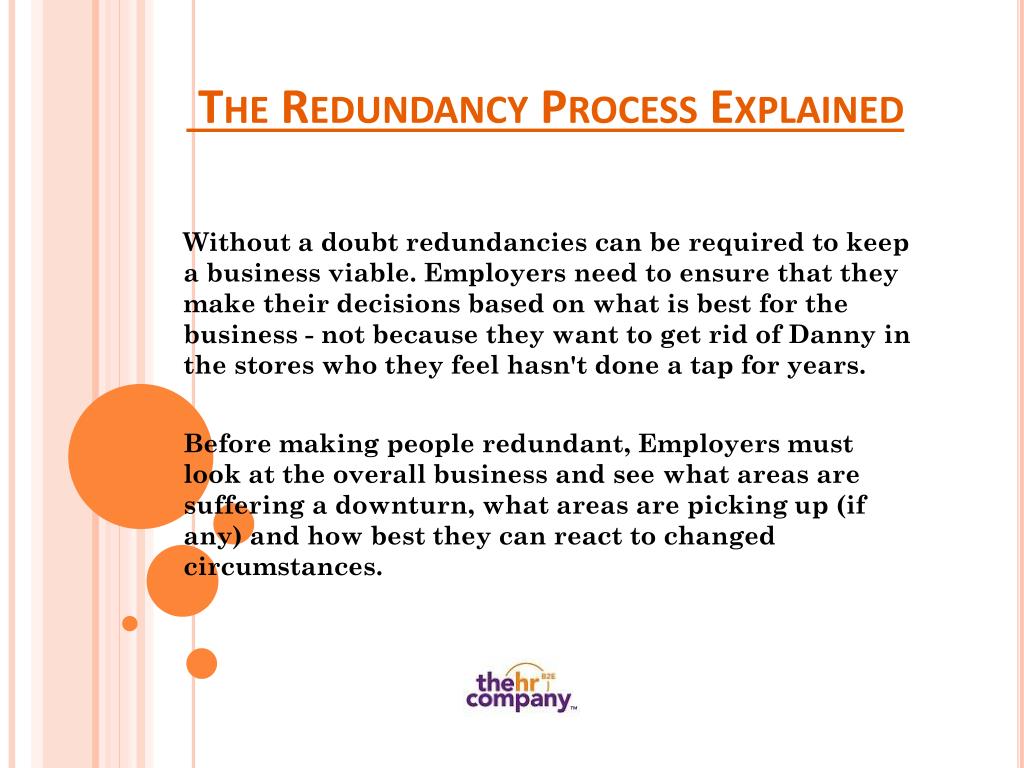Who Pays Redundancy Money? A Comprehensive Guide for Employers and Employees
Who Pays Redundancy Money? A Comprehensive Guide for Employers and Employees
Blog Article
Examining the Interplay In Between Firm Redundancy and Business Versatility for Future Growth
In the vibrant landscape of today's service world, the intricate relationship between firm redundancy and organizational flexibility arises as a critical element for sustained growth and success. Business usually face the challenge of striking a fragile equilibrium between maintaining a level of redundancy to reduce dangers and promoting versatility to react quickly to the ever-evolving market needs.
Importance of Company Redundancy
Business redundancy is a vital aspect that boosts organizational strength and alleviates functional risks. By including redundancy actions within the business structure, business can much better withstand unpredicted disturbances and fluctuations in the business setting. Redundancy functions as a strategic buffer, enabling companies to adapt and react successfully to unexpected difficulties without jeopardizing vital procedures.
One trick aspect of the significance of firm redundancy is its duty in making certain connection throughout times of crisis. When encountered with sudden changes or emergencies, redundant systems, resources, or workers can action in to preserve essential functions and stop widespread disruptions. This continuity not only safeguards the company's credibility and consumer trust fund but likewise minimizes economic losses and functional downtime.

Strategies for Business Versatility

An additional essential method is purchasing modern technology and infrastructure that can support versatility and scalability. Applying electronic devices, automation, and information analytics can simplify procedures, boost efficiency, and provide important insights for notified decision-making. Additionally, developing versatile business frameworks that enable fast changes to market characteristics and client requirements is crucial for staying affordable in a swiftly evolving setting. By proactively recognizing possible disturbances and possibilities, companies can proactively flourish and adapt in an ever-changing company landscape.
Harmonizing Redundancy and Flexibility
Accomplishing an unified balance in between functional redundancy and organizational versatility is paramount in navigating the intricacies of a vibrant business atmosphere. Striking the appropriate balance between redundancy and versatility is a delicate process that needs a deep understanding of the company's goals, industry dynamics, and danger resistance.
To achieve this balance, companies require to conduct regular assessments of their operations to identify areas where redundancy is necessary for risk mitigation and where adaptability can drive development and development. Applying flexible frameworks, cultivating a society of continual discovering and renovation, and motivating open communication across all degrees of the organization are key strategies to integrate redundancy and flexibility successfully. By lining up these two vital elements, companies can place themselves for lasting development and success in an ever-changing business landscape.
Case Studies on Adaptation Success
In taking a look at circumstances of effective business adaptation, it comes to be noticeable that the interplay between operational redundancy and adaptability is a defining aspect in forming resistant organizations. A DVD rental solution, Netflix showed remarkable flexibility by transitioning into a streaming platform when digitalization disrupted the industry. These case research studies highlight the importance of operational redundancy combined with organizational versatility in promoting long-lasting growth and competition.
Building Durability for Future Growth
Building resilience for future development needs a critical placement of operational procedures with market dynamics and arising patterns. Firms should adapt to altering environments by cultivating a society of versatility, technology, and continual renovation.
Furthermore, cultivating strong partnerships with stakeholders, such as customers, staff members, providers, and the area, is vital for weathering uncertainties and preserving trust and assistance throughout rough times. Reliable communication and openness play an essential role in structure strength, as they help assist in and align expectations cooperation in browsing uncertainties.
Additionally, companies require to prioritize knowing and advancement campaigns to upskill employees and equip them with the needed devices to adapt to altering circumstances. By purchasing their labor force, companies can enhance their flexibility and dexterity, ultimately strengthening their durability for sustainable future development.
Conclusion

In the vibrant landscape of today's company globe, the intricate partnership between business redundancy and business adaptability emerges as a crucial aspect for continual growth and success. Business often face the difficulty of striking a fragile balance between preserving a level of redundancy to reduce risks and cultivating official site flexibility to react quickly to the ever-evolving market demands.To accomplish this equilibrium, firms need to carry out routine evaluations of their procedures to recognize locations where redundancy is needed for threat mitigation and where adaptability can drive advancement and development.In conclusion, the interplay between company redundancy and organizational versatility is essential for future development. Building read here resilience through a mix of redundancy and flexibility will ensure that companies are prepared for the challenges of the future.
Report this page